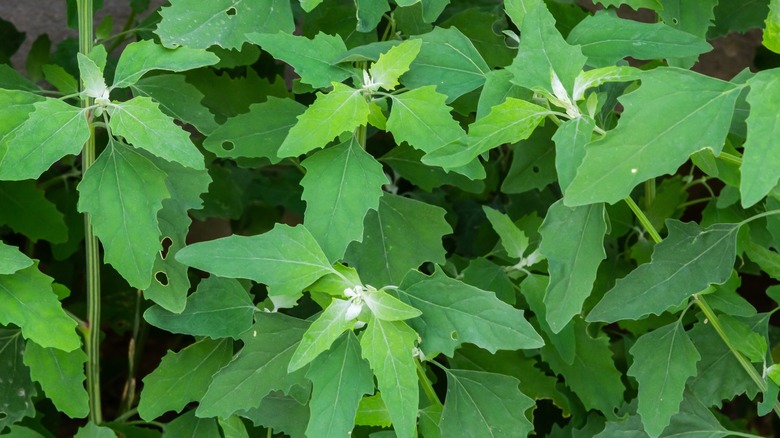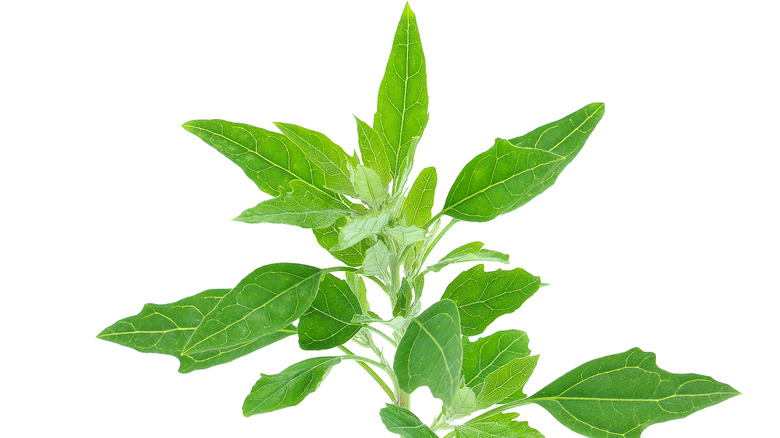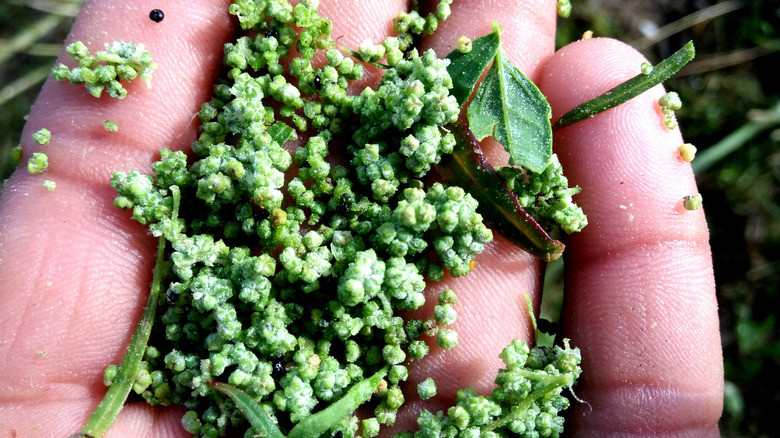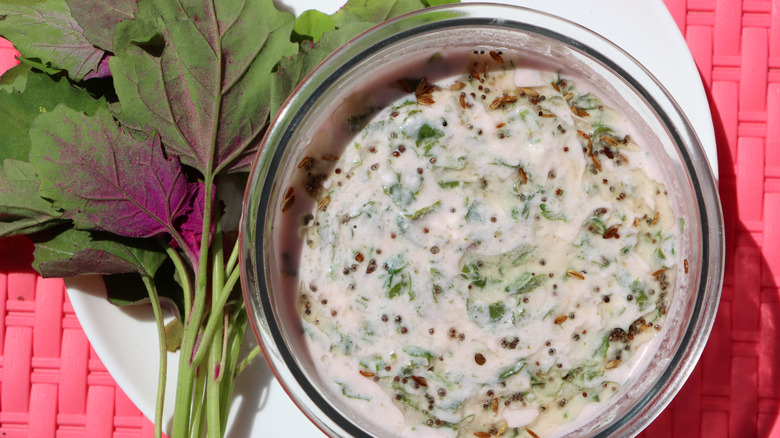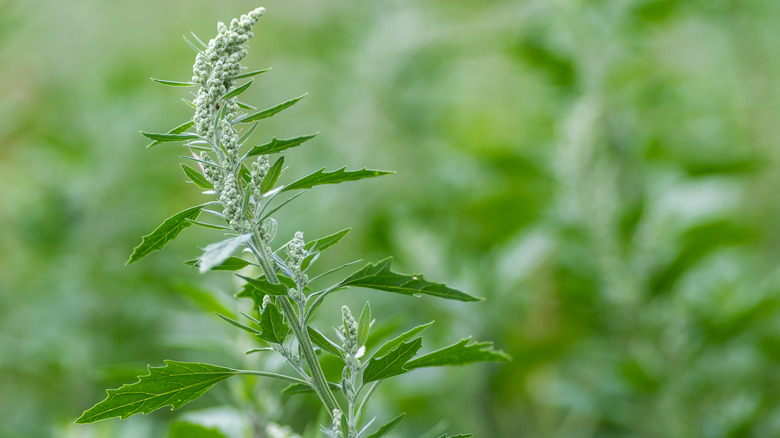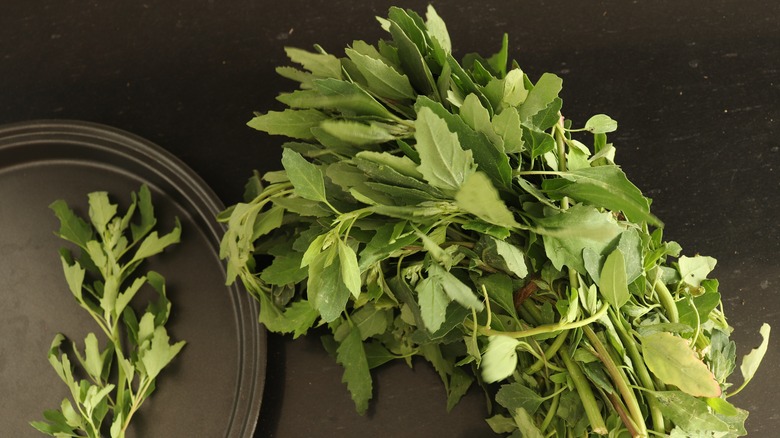If You Like Spinach, Try Its Wild Cousin Lambsquarters
Lambsquarters (Chenopodium album) is a wild leafy green that goes by many names. Among those, it is sometimes called "goosefoot" because of its forked-leaf appearance and is sometimes referred to as "wild spinach." The list goes on, and many nicknames for this plant are increasingly unflattering. Regardless of what you call it, lambsquarters is an underrated green that has a reputation for being a weed or something to be yanked from your garden immediately.
However, you don't have to throw lambsquarters onto your garbage pile. Lambsquarters is actually a highly versatile green in the kitchen and packs more nutrition per serving than many comparable and widely accepted greens. Once picked, it is fairly easy to prepare in several ways and can surprisingly add a lot to your plate. So if you like incorporating spinach and other leafy greens into your meals, chances are you're going to want to give lambsquarters a try.
What is lambsquarters?
Lambsquarters is part of the family Amaranthaceae, which includes spinach, chard, and sugar beets. But there's a reason that lambsquarters is commonly thought of as a weed. Lambsquarters is thought to be native to Europe and is now an invasive species that is found all over the world. It has a rich documented history in many corners of the globe — Europe, Asia, the Americas, Australia, and more.
Despite evidence showing that lambsquarters has been in the United States for over 400 years, it is sometimes still thought of as a troublesome species that will grow just about anywhere there's disrupted dirt. Lambsquarters produces a lot of seeds and can quickly take over a backyard garden. Fortunately, you can eat it.
Lambsquarters grows in stalks off the ground, often reaching between three and six feet tall. Mature leaves are roughly diamond-shaped. New leaves will have a white sheen on them, which disappears from the top of the leaves as they reach maturity but will remain on the underside of the leaves. Despite its reputation for being a nuisance in some cases, lambsquarters historically has been a dependable source of nutrition for people for generations.
What does lambsquarters taste like?
Lambsquarters' leaves taste very similar to spinach. New leaves are tender and springy when eaten raw in salads or sandwiches. Older leaves may be tougher and better cooked than eaten raw. Once cooked, lambsquarters has an enjoyable mineral-like taste that is similar to other common steamed or sautéed greens. This hearty, earthy taste makes it a good addition to savory dishes that need something fresh and green.
Lambsquarters will lose their flavor quality if they are kept for more than a few days after picking, but fortunately, you can preserve the leaves for up to a year by blanching and freezing them. This retains their taste and extends their life well past their typical picking season. The seeds, which you can eat whole or ground into flour, have a taste that is comparable to amaranth or buckwheat. This nuttiness is a pleasant addition to baked goods or cereals.
How to cook with lambsquarters
Anything that you can put spinach in, you can also use lambsquarters for. Lambsquarters' leaves are easy to prepare, but they have a short shelf life. You can store them in the refrigerator for a few days, but it's best to use them right after they are picked. After you clean them and separate the leaves from the stalk, one of the easiest ways to eat them is simply by adding them to a greens mix in a salad, like a Fattoush salad with pomegranate molasses.
The other common way to consume lambsquarters is by cooking it down. Simply sauté until tender and add to any dish that calls for cooked greens, like a simple sauteed dandelion greens recipe or an amaranth polenta with kale dish. You can also harvest the seeds after cleaning them and add them to bread, muffins, cereals, and more. You can use the seeds whole, but if you have access to a grinder, you can also pulse the seeds into flour.
Where to buy and how to forage lambsquarters
Unfortunately, it's not likely that you'll find lambsquarters in the grocery store. But you might get luckier if you try a farm stand or farmer's market. Lambsquarters are widely viewed as a weed and often not treated as a domestic plant. But some growers have embraced lambsquarters' willingness to grow wherever and intentionally plant it.
More likely, if you'd like to try lambsquarters, you'll have to forage for it yourself. The peak season for lambsquarters is spring to early fall. Leaves of lambsquarters start out looking triangular and have a thin white coating on them. As the leaves mature, they will grow into their signature forked diamond shape. The white sheen will disappear from the tops of the mature leaves but remain on the underside.
To harvest, simply cut off the newest-looking growth near the top. Anything that is too mature might be overly tough in texture. Towards the end of the season, when the plant goes to flower, you can harvest the seeds as well. Clip the flowering part once it is brown on the outside.
But be careful — anytime you are foraging for edible wild plants, make sure you have done your research and know how to properly identify what you are looking for. Incorrectly identifying plants, you plan to eat can be very dangerous. Likewise, you should avoid lambsquarters grown in artificially fertilized or contaminated soil because it may take up problematic chemicals from the environment it is grown in.
Nutritional information about lambsquarters
One of the great things about lambsquarters is that you can eat the leaves, stems, and seeds, and they all bring important nutritional benefits. Lambsquarters is very good for you, and some say it even outperforms other healthy greens like spinach and cabbage. Lambsquarters is high in vitamin E, vitamin C, and B vitamins. These vitamins can help prevent oxidative stress caused by harmful molecules, thereby helping to prevent diseases and damage to tissue. It is also a great source of other important nutrients such as calcium, manganese, and iron.
Like more common spinach, lambsquarters contains oxalic acid. This is a component that isn't good for you if you eat large amounts of it (via Specialty Produce). However, cooking lambsquarters can reduce the amount of oxalic acid you consume.
Lastly, stems and seeds can provide you with dietary fiber and can promote a healthy digestive tract. The seeds can be added to things like oatmeal or used as a flour replacement. All in all, lambsquarters is a highly nutritious green that can add healthy benefits as well as flavor to almost any meal.
